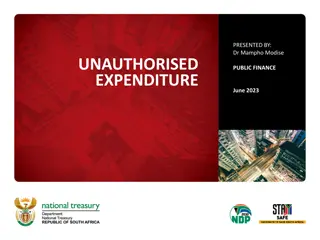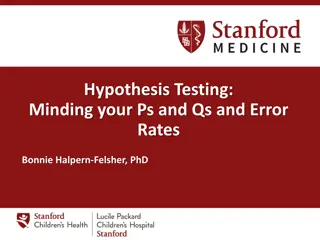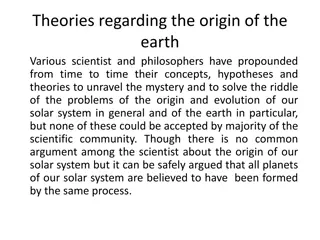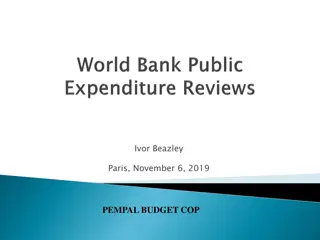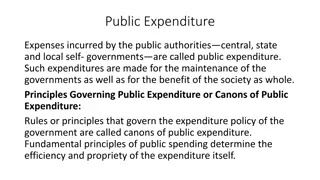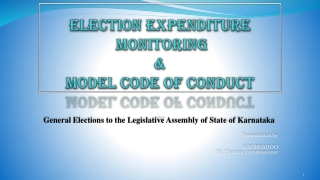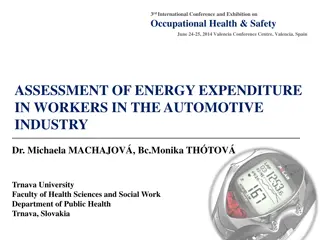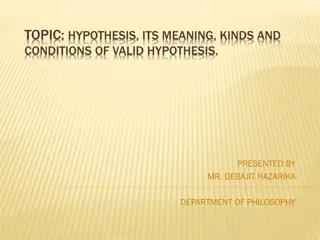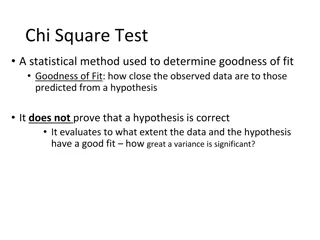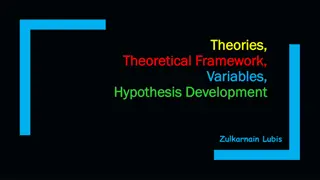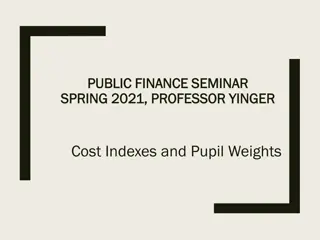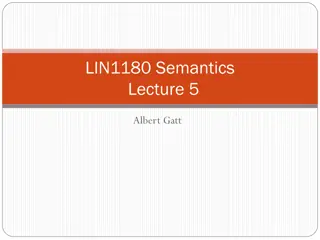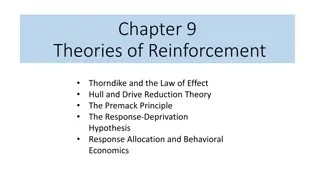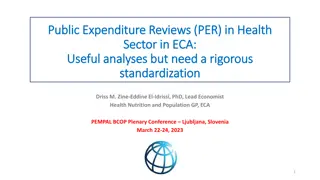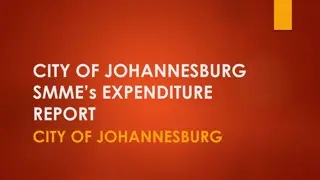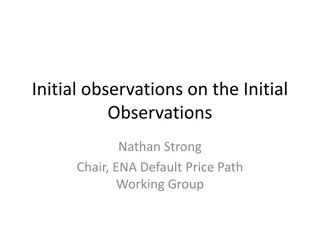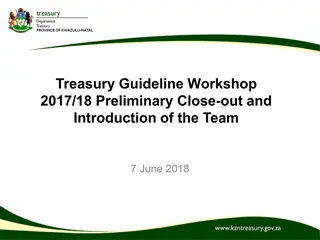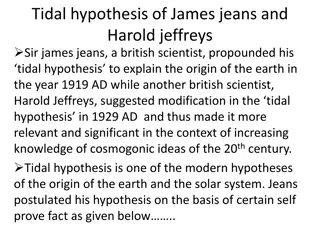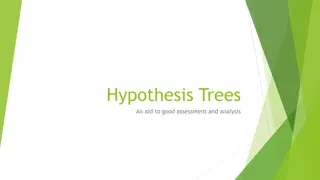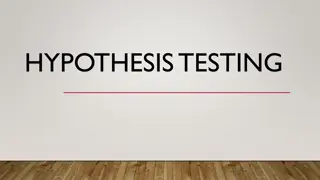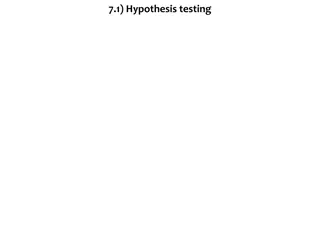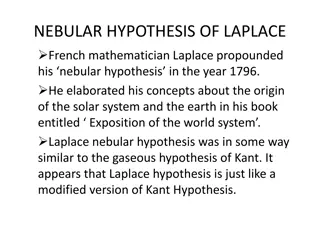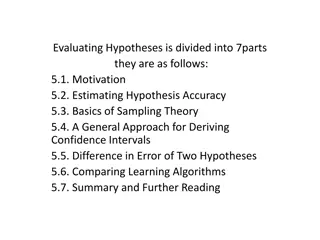Theories of Growth in Public Expenditure: Adolph Wagner's Hypothesis
Adolph Wagner, a prominent German economist, put forth a hypothesis on the growth of public expenditure, linking it to economic development. Wagner's theory suggests that as per capita income rises, public expenditure increases proportionally due to expanded traditional functions, coverage of new functions, and social progress.
Download Presentation

Please find below an Image/Link to download the presentation.
The content on the website is provided AS IS for your information and personal use only. It may not be sold, licensed, or shared on other websites without obtaining consent from the author. Download presentation by click this link. If you encounter any issues during the download, it is possible that the publisher has removed the file from their server.
E N D
Presentation Transcript
Unit II Public Expenditure In modern times all the countries of the world have witnessed an enormous increase in public expenditure. There are three important and well known theories of growth of public expenditure. The first theory is associated with the name of German economist, Adolph Wagner.
Adolph Wagners Hypothesis Adolph Wagner a noted German political economist (1835-1917) propounded an empirical law to analyses and explains the trend in the growth of public expenditure. Wagner argued that a functional, cause and effect relationship exists between the growth of an industrializing economy and the relative growth of its public sector. Wagner believed that a functional cause effect relationship prevailed between economic growth and growth in public expenditure. His hypothesis of the increasing state activity lays that as the per capita income and output increase in advanced countries the public expenditure of these countries necessarily grows as a proportion to the total economic activity. F.S Nitti supported Wagner s hypothesis and concluded with the support of empirical evidence that this law was not only applicable to Germany but to various governments which differed widely from each other. The following are the important causes responsible for this tendency.
1. Expansion of Traditional functions Traditional functions mainly include defence, administration of justice, maintenance of law and order and provision of social overheads. The coverage and variety of such functions have gradually increased. Defence expenditure has expanded rapidly because of a change in military arts and sciences. In modern times military activities has become sophisticated. From simple aggression, the modern warfare shifted to prevention of attack and use of sophisticated weapons. Defence outlays on men, materials and maintenance have been on a rising trend in modern times. Similar is the case with expenditure on internal protection and administration. Increasing areas of administration and spread of government machinery with expertise have become more and more expensive.
2. Coverage of New Functions Secondly the activities of the state were increasing in their coverage. Traditionally the state activities were limited to only defence, justice, law and order, maintenance of the states over heads etc. But with the growing awareness of its responsibilities to the society, the governments started expanding its activities in the field of various welfare measures to enrich the cultural life of the society. Along with this new welfare programmes were designed to provide social security to the people. This required increasing government expenditure on education, public health, low cost housing, subsidized provision of food, agricultural inputs, old age pension, sickness benefit etc.
3. Social Progress Wagner believed that social progress was the basic cause of the relative growth of government in the industrial economics. Social progress leads to a growth in government function which in turn leads to the absolute and relative growth of governmental economic activity.
4. Expanding Sphere of Public Goods Almost all modern democratic governments have increasingly recognized the need to provide and expand the sphere of public goods. The need and necessity to provide social and merit goods through budgetary allocation was increasingly recognized by the modern state. The state was trying to shift the composition of national product more in favour of public goods. As a result state activities expanded to areas like irrigation and flood control projects, construction and maintenance of public parks, provision of education and health care facilities, creation of economic overhead capital etc., Provision of these public goods and merit goods means heavy investment in public enterprises. Apart from the above mentioned factors, Wagner also examined the forces that operate on both the demand and supply side of public sector activity and explained how they interact. Changing production and marketing arrangements of public sector activity affect and are affected by social organizations in different ways.
5. War and Preparation of War The most important contributory factor in incurring the public expenditure in the current century is war. Expenditure on national defence generally accounts for half and at times even more than half of the total budget expenditure. The tremendous growth in public expenditure may also be attributed to wars and threats of war in modern times. In the Second World War, countries like England incurred heavy war expenditures, amounting to 15 million per day. Wars and threats of war and the consequent defence needs compel governments to spend more and more on the production of war goods. Due to the invention of nuclear weapons, there is always the danger of foreign aggression. International political situation is uncertain and insecure. Modern States are already facing a cold war. As such, every nation has to prepare itself for strong defence.
6. Growth of Population A high growth of population naturally calls for increase in the expenses as all State functions are to be performed more extensively. Rising population also poses various problems in poor countries. The State will have the added responsibility of solving such problems as food, unemployment, housing and sanitation. Further, overpopulated countries like India will have to check the population growth. The State has, therefore, to spend more and more on family planning campaigns every year.
7. Urbanisation The spread of urbanisation is an important factor leading to the relative growth of public expenditure in modern times. With the growth of urban areas, there has been an increasing tendency of expenditure on civil administration. Expenses on water supply, electricity, provision of transport, maintenance of roads, schools and colleges, traffic controls, public health, parks and libraries, playgrounds, etc. have increased enormously these days. Likewise, the expenditure on courts, prisons etc. is increasing, especially in the urban sector.
8. Rise in Prices and National Income According to Musgrave, a rising share of public expenditure in national income is associated with a rise in per capita income. Thus, an increase in per capita income over a period of time may cause a relative rise in public expenditure. This is because the demand for public goods tends to expand with the rise in per capita income. Usually, it rises faster than the latter. Secular rise in prices and national income have led to a significant increase in the absolute amount of public expenditure.
9. Economic Planning and Growth The ideals of economic planning and growth are being increasingly accepted. This implies an increase in public sector as also various efforts on the part of the government towards capital accumulation and economic growth.
10. Specialisation The nature and size of public services now need specialisation. The quantity of the services improves, both as a historical fact as also due to circumstantial compulsions. Better quality services and higher qualified administrators, technicians and the like imply a higher cost of providing public services. Moreover, the heads like Economic Protection, Complexities of Modern Life and Mounting Public Debt also increase the public expenditure.
Graphic Presentation of the Wagner Hypothesis:
The modern formulation of Wagners law is that as per capita income rises in industrializing nations, their public sector will grow in relative importance. The Wagner s hypothesis of increasing state activity is illustrated in the above figure. In the figure the real per capital output of public goods (PG) is measured on the vertical axis and real per capita income (Y) is measured on the horizontal axis. Time is an important third dimension implicit in the graph, because the growth in the real per capita output of public goods and in real per capita income is realistically assumed to take place on a historical basis over an extended period of time. Line PG1 represents a circumstance in which the public sector maintains a constant proportion of the total economic production of the society over time.
In other words, as real per capita income increases, due to economic development of the society, the real per capita output of public goods remains at the same proportion of total economic activity. The constant proportion line, PG1, can be used as a reference point to the graphical presentation of Wagner hypothesis as depicted by the line PG2. All along the PG2 the proportion of resources devoted to the output of public goods is expanding overtime. The implication of Wagner s law can be stated in the following equations. When the real per capita output of public goods remains at the same proportion of total economic activity, i.e. PG1, the equation is PGa/Ya = PGo/Yo In other words the income elasticity of expenditure for public goods (Ye) is elastic. Wagner s hypothesis provides the most suitable frame work for explaining economic factors, as the most important determinant of a relatively expanding public sector during industrialization and economic growth. The functional relationships, Wagner sought to trace are complex. Wagner believed that increased public expenditure was the natural result of economic growth and the continued pressure for social progress.
Criticism of Wagners Hypothesis: Although the Wagner hypothesis has many attributes, it also has several defects. Wagner s law of increasing state activity was criticized by Allan. T. Feacock and Jack Wiseman on the following grounds: i. Wagner s hypothesis deals with inter-disciplinary phenomenon. But it lacks interdisciplinary approach in its analytical framework. ii. Lacks comprehensiveness in analysis Wagner s law lacks comprehensiveness. Political science, economics and sociology are among the several disciplines to be incorporated in any theory of public expenditure. The Wagner s hypothesis excludes all these characteristics. iii. It is based on an organic self-determining theory of the state, which is not the prevailing theory of the state in most western countries. iv. It stresses a long term trend of public economic activity, which tend to overlook the significant time pattern or process of public expenditure growth.
Wiseman and Peacock Hypothesis Another hypothesis regarding the growth of public expenditure was put forth by Wiseman and Peacock, in their empirical study of public expenditure in U.K. for the period 1890-1955. The main thesis of the authors is that public expenditure does not increase in a smooth and continuous manner. The increase in public expenditure over time has occurred in jerks and step-like manner. Wiseman and Peacock emphasize the time pattern of public spending trends rather than striving for a genuine positive theory of public sector growth. Their analysis involves three related elements. These are displacement, inspection and concentration effects.Using empirical data for the British economy after 1890, Wiseman and Peacock observe that the relative growth of the public sector in the United Kingdom has followed a discrete step like pattern rather than a continuous growth pattern. During the period under study they found that, government fiscal activities, in the country have risen step by step to successive new plateaus. Moreover the absolute and relative increases (steps upward) in taxing and spending activities by the British government have generally taken place during periods of major social disturbance or crisis such as war or depression. These kinds of changed fiscal situation cause the previous lower tax and expenditure levels to be replaced by new, higher, budgetary levels. This movement from the older level of expenditure and taxation to a new and higher level is called the displacement effect after the social disturbance has ended; the new level of tax is tolerated by the society. The emerged new levels of tax tolerance make the society willing to support higher levels of public expenditure. Thus there is no strong motivation to return to the lower pre-crisis level of taxation. Over the secular period, 1890 -1955, this displacement procedure occurred several times in Great Britain. Thus when the major social disturbance ends, no strong motivation exists for the society to return to the lower pre-disturbance level. The higher government revenues are used to support permanently higher levels of public sector allocation.
Figure demonstrates the displacement effect, tax threshold behaviour. Time (years) is measured along the horizontal axis, while public sector revenues (mostly taxes) and public expenditures as a percentage of gross national product are measured along the vertical axis. The figure reveals that as the social disturbance cause a relative expansion of the public sector, the displacement effect which occurs helps to explain the time pattern by which the government growth takes place. This displacement effect does not require that the new higher plateau of expenditure, continue the same expenditure composition that was created by the social disturbance. Some of the increased expenditures like debt interest are the direct results of the social disturbance. While other expenditures arose as a result of technological development and expansion of government activity into new areas. For instance, war and other social disturbance, frequently force the people and their government to find out a lasting solution to the long standing and pending problems, which were previously neglected. This is known as inspection effect . Inspection effect is the inadequacy of revenue in comparison with the required public expenditure.
In addition to the displacement and inspection effect, Peacock and Wiseman, also give narration about a concentration (scale) effect. It refers to the apparent tendency for the central government economic activity to become an increasing proportion of total public sector economic activity, when a society is experiencing economic growth. This occurs, because central government has to initiate a number of measures to sustain higher economic activity. Since each major disturbance leads to a situation in which, the central government assuming a larger proportion of the total national economic activity, the net result is the concentration effect . Wiseman Peacock hypothesis appears to be quite relevant. At the outlet, the hypothesis looks quite convincing. It emphasizes jerks and jumps in public expenditure, on account of unusual and abnormal situations. According to Prof. Aronson, for Peacock and Wiseman expenditure growth is sporadic rather than constant and revenues create their own expenditures. However, we must not forget the fact that, an account of the advance of the economy and the structural changes therein, there are constant and regular increments in public expenditure and revenue.Public expenditure has a tendency to grow on account of a systematic expansion of government activities, both in terms of intensity and quality. The regular and dynamic changes in state activity and public spending caused by macro variables like population growth, urbanization, awareness of civic rights on the part of citizens and political and social commitments on the part of democratic governments voted to power are major factors giving a big push to upward trend in public expenditure. However, the influences of these factors on government spending were not systematically analyzed by Wiseman and Peacock in their hypothesis. However, Bernard. P. Herber sincerely argues that the Peacock Wiesman hypothesis of governmental spending trends, is much more modest in what it intend to explain than in Wagner s hypothesis. The fact is that, both the Wagner s and Peacock. Wiseman narrations contribute a lot in understanding the process of public sector growth in industrialized nations.
Pure theory of Public Expenditure In 1954 Paul Samuelson published his landmark paper The Pure Theory of Public Expenditure, which formalized the concept of public goods (which he called "collective consumption goods") -- i.e. goods that are non-rival and non- excludable. He highlighted the market failure of free-riding when he wrote: "it is in the selfish interest of each person to give false signals, to pretend to have less interest in a given collective consumption activity than he really has". His paper showed that "no decentralized pricing system can serve to determine optimally these levels of collective consumption". Excludability is the ability of producers to detect and prevent uncompensating consumption of their products. Rivalry is the inability of multiple consumers to consume the same good. A public good is defined as a non-rival non- excludable good, such as national defence. Because public goods are not excludable, they get under-produced. The pricing system cannot force consumers to reveal their demand for purely non-excludable goods, and so cannot force producers to meet that demand. The evidence for under-production of public goods is so overwhelming that, as professor Walter Block admits about the resulting justification for state intervention, "virtually all economists accept this argument. There is not a single mainstream text dealing with the subject which demurs from it." Exhibit 1 gives the clear understanding of the theory.
Structure and Growth of Public Expenditure There has been a phenomenal increase in public expenditure in almost all the countries of the globe. This tendency which was noted in the previous century has become crystallised in the present century. The classical economists assumed the state has very limited functions under the laissez faire policy. The functions of the state were restricted to justice, police and arms. According to J.B. Say the very best of all plans of finance is to spend a little . But today the role of the state has changed under the welfare criterion and there is a persistent trend towards an extensive and intensive increase in the scale of governmental performance.
1. Welfare State Ideology The modern State is a welfare state. It aims at promoting the economic, political, and social well-being of its citizens. It makes every effort to improve the living standard of the common people. For this purpose, it has to undertake may functions and services never visualised before.Even in an avowedly capitalistic economy, there has been increasing State intervention through legislative and administrative measures for augmenting production and improving distribution. Many wants which were formerly satisfied individually by private meansare now satisfied collectively through publicexpenditure. In the classical era, the State was assumed to have a very limited function under the laissez faire policy. The functions of the State were restricted to justice, police, and army. Today, however, the role of the State has changed under the welfare criterion and there is a persistent trend towards an extensive and intensive increase in the scale of governmental performance. Apart from performing old functions more efficiently and on a larger scale, a modern State constantly undertakes new functions and added responsibilities day byday. It now embraces many new ideas such as social insurance, unemployment relief, and provisions for underprivileged classes. In order to reduce inequalities of income, the State has to spend a large sum on free and cheap medical aid, subsidised food and housing, free education. Especially in underdeveloped countries such as India, the State expenditure on these social services is rising fast. In India, for instance, expenditure on social service is rising fast. In India, for instance, expenditure on social services has gone up from `419 crores in the First Plan to `2,772 crores in the Fourth Plan. In the Seventh Plan, it was envisaged to be `29,350 crores. In each five year plan, India has been providing a significant portion of the total plan outlay for the health sector in order to provide quality health care to all needy people. The percentage of plan allocation to health sector increased from 3.4 in the first plan to 6.5 per cent in the eleventh plan. In the same pattern, the per capita expenditure also increased from `0.61 in the first plan to `214.62 in the eleventh plan. In the 12th five year plan, the government has decided to boost public spending in the sector to 2.5 per cent of GDP from 1.27 per cent in the 9th five year plan. The central government outlay for the health sector in the twelfth plan has been increased by about 335 per cent to `300018 crore over the actual outlay of `99491crore in the 11th plan. Due to the pressure of social progress under the welfare state theory, in addition to the maintenance of law and order, government participation in the economic field for the provision of some goods, such as communication, education, medical facilities, etc. was necessitated. In short, the Wagner hypothesis states that in a welfare state, as the economy expands, publicexpenditure will also tend to increase persistently.
2. The Need for Defence International political situation is insecure and uncertain. Due to the invention of nuclear weapons, there is always the danger of foreign aggression. Modern States are already facing a cold war. As such, every nation has to prepare itself for strong defence. The defence expenditure is thus continuously rising. It contains expenditure on war materials, maintenance and growth of armed forces, naval and air wings, expenses on the development of military art and practice, pensions to retired war personnel, interests on war debt, cost of rehabilitation, etc.
3. The Influence of Democratic Forces The democratic structure of government is more expensive than totalitarian government. In India democracy is becoming a very costly affair. The Expenditure on elections and bye-elections is increasing. The recent growth of democracy and socialism everywhere in the world has caused public expenditure to increase very much. The number of ministries and executive offices has also been increasing. Further, the ruling party has to fulfil its promises and launch upon new policies and programmes to achieve socialist objectives, in order to create a favourable image in the public. This also requires increasing State expenses in order to provide new amenities and opportunities to the people at large.
4. The Urbanisation Effect The spread of urbanisation is an important factor leading to the relative growth of public expenditure in modern times. With the growth of urban areas, there has been an increasing tendency of expenditure on civil administration. Expenses on water supply, electricity, provision of transport, maintenance of roads, schools and colleges, traffic controls, public health, parks and libraries, playgrounds, etc. have increased enormously these days. Likewise, the expenditure on courts, prisons etc. is increasing, especially in the urban sector
5. The Rural Development Effect In an underdeveloped country, the government has also to spend more and more for rural development. It has to undertake schemes like community development projects and other social measures.
6. The Population Effect A high growth of population naturally calls for increase in the expenses as all State functions are to be performed more extensively. Rising population also poses various problems in poor countries. The State will have the added responsibility of solving such problems as food, unemployment, housing and sanitation. Further, overpopulated countries like India will have to check the population growth. The State has, therefore, to spend more and more on family planning campaigns every year.
7. The Growth of Transport and Communication With the expansion of trade and commerce, the State has to provide and maintain a quick and efficient transport system. Transport being a public utility, the State has to provide it cheaply also. Hence, railway and passenger transport is nationalised. Government has, therefore, to run transport services even at a loss. This obviously calls for a high expenditure for maintenance and expansion. Further, the government in a poor country has to spend a lot on constructing new railway lines, new roads, national highways, bridges and even canals to connect the different areas with a smooth transport system as a precondition of growth.
8. The Planning Effect The government through the planning commission formulates and implements plans to provide full employment, reduce inequalities of income and wealth distribution, bring about a balanced regional development and to achieve a number of other socio-economic objectives. The government has to spend huge sums on planning leading to an increase in public expenditure. In a less developed economy, the government adopts economic planning for the development of the country. In a planned economy, thus, when the public sector is expanding its role, public expenditure obviously shows an increasing trend. In India, for instance, the public sector outlay during the First Five Year Plan was just Rs. 1,960 crores, which is now estimated at Rs. 2, 47,865 crores during the Eighth Plan period (1992-97).
9. Inflation With the rising prices, the government has to keep on increasing public expenditure to carry out its functions and maintain the supply of public goods intact. During inflation, the government has to pay additional DA to its employees which obviously call for an extra burden on public expenditure.
10. Industrial Development Industrial production contributes to increase in national income and it improves the standard of living. It is evident from the Five Year Plans, which gives top priority in the second five year plan. After that, industrial sector, in India, blooms everywhere and in turn backward regions of our country also gets benefited. Obviously all these developments are resulted by way increasing in public expenditure.
11. Education In any country, social and political development can never take place unless the citizens are educated. In order to carry the benefits to weaker sections of society, the government offers them free scholarships and even maintenance grants which enable them to buy books. Hence, a substantial increase in public expenditure is needed of the hour.
12. Servicing of Large Public Debt Modern governments require huge finance for its various development activities. It cannot raise funds by taxation alone. Therefore it must resort to internal and external borrowing. Hence it has to pay interest and repay capital. This leads to an increase in public expenditure.





